Alaska Fish & Wildlife News
January 2017
Wandering Lynx
Lynx Research in Alaska and Canada
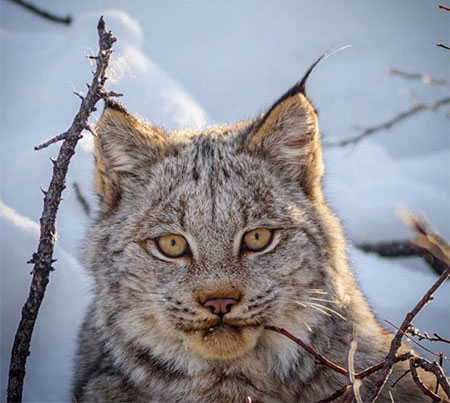
A hungry lynx raiding a chicken coop in Southcentral Alaska provided some surprises for the couple that live-trapped it and the biologists that showed up to move it.
Ralph and Linda Lohse live at Kenny Lake near Copper Center, about 175 miles east of Anchorage. They first saw the lynx on Oct. 16, 2016. Over the course of a week or so, the lynx killed and ate six chickens, three domestic ducks and attacked a sheep that later died from the bite wound on its throat.
“When he killed the sheep we knew we had to get him,” said Ralph Lohse. Lohse has trapped in the Copper River valley since 1967, and he’s quite familiar with lynx. He’s also fascinated by the animals.
“I’ve probably skinned 400 lynx and I’m not anxious to skin another one, so my first thought is not to kill a lynx,” he said. “These are animals that paid our bills a lot of winters, and we’re extremely interested in them. We’re into animals."
He said the lynx was in beautiful shape for October. In addition to the fur coat, Lohse saw the lynx was also wearing a GPS tracking collar and realized a biologist somewhere was using the animal to study lynx behavior and movements. He knows that lynx can travel impressive distances, especially when snowshoe hares decline. Lynx numbers are tied to snowshoe hare numbers, and hare populations fluctuate in a roughly ten-year “boom and bust” cycle. Hares may be as much as ten times more abundant in the peak years as compared to the low years, and the timing of the cycles is different in different parts of the north.
“We’ve had major movements of lynx along the Chitina River down to the coast,” Lohse said. “After one of our peak seasons and the hares die, the lynx will head down the Copper River to the Chitina River, and go right down by the ocean. I have a friend who trapped a collared lynx in our area that had come all the way from the Kenai, more than 400 miles.”
So how do you catch a lynx alive and unharmed? It turns out Lohse is adept at the practice from his years as a trapper. He said in late winter and early spring lynx have a tendency to become “rubbed,” which reduces the quality and value of their pelt. He said the foothold traps he used did not injure the cats and rather than take a lynx that was rubbed, he’d just let them go. Heavy gloves or mittens are essential, as is avoiding the sharp claws and two-centimeter-long, needle-sharp canine teeth.
“Handling lynx doesn’t really worry me too much, there are a number of ways you can release them unharmed,” he said. “I’ve probably released between 50 and 70 alive. Lynx are so quick, but they’re not that strong. They’re easy to subdue. Once you’ve got ahold of it, it’s no problem.”
The lynx had become so comfortable around the Lohse’s place that one day they were able to simply walk up and shut him in the chicken coop.
They called The Alaska Department of Fish and Game in Glennallen, about 40 miles away. State wildlife biologists Frank Robbins and Heidi Hatcher were aware that researchers at the Tetlin National Wildlife Refuge near Tok were studying lynx, and figured they likely collared the animal.
When U.S. Fish and Wildlife service biologists Dashiell Feierebend and Dana Fjare arrived, they realized the lynx was not one of “their” collared animals. It turned out this Kenny Lake lynx had been captured and collared 10 months earlier at a study area 250 miles away near Kluane Lake in the Yukon Territory by Canadian researchers. The researchers had lost track of the lynx near the US-Canada border in March 2016 when it moved out of range. Feirebend and Fjare replaced the collar and at Frank Robbins’ suggestion they drove the sedated lynx 49 miles south – halfway to Valdez – and released it. They returned the collar to their Canadian colleagues.
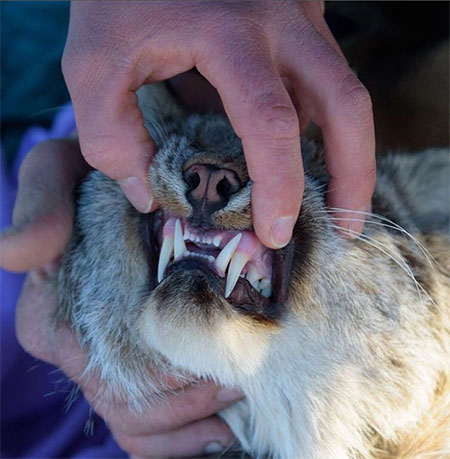
It turns out that a number of researchers in Alaska and Canada are studying lynx, and they have some amazing tools at their disposal. They are gaining insights into these wild cats of the north and their dietary mainstay, snow shoe hares.
Tagged kittens
The USFWS researchers in Tetlin have collared 22 lynx since March 2015. This has enabled them to find dens, and they’ve visited five dens since June 2015. They’ve documented and ear-tagged four to six kittens at each den – a total of 24. Wildlife biologist Nate Berg said as far as he knows, these are the first lynx dens documented in Alaska. Four of the dens are in the Tetlin National Wildlife Refuge and one is outside.
“The dens are always near really good snowshoe hare habitat,” Berg said. “They’re in thick downfall, really thick brush, places you don’t want to go. One den was in thick jackstrawed spruce trees. Mom is right there, sitting on the den.”
He said the mom moves off a short distance as they quickly weigh and measure the kittens, take a genetic (hair) sample, and ear tag the kittens. The mom comes right back
The tags allow researchers to identify the cats. In the past, hunters and trappers that have harvested tagged lynx have returned the tags, providing information about dispersal and movement.
“If we catch them later in the study area to collar them, we know who mom is,” he said. That’s more insight into dispersal, age and home ranges.
The Tetlin researchers have also captured and ear-tagged 40 snowshoe hares, as part of a mark-recapture study to estimate the hare population. They can compare the results to another method they use to estimate hare numbers, pellet group transects. They’re monitoring the snowshoe hare cycle in the Tetlin area, and collaborating with other biologists in Interior Alaska to better understand the phenomena.
Big feet
Heidi Hatcher is a state wildlife biologist based in Glennallen. She said lynx are pretty common in the Copper River region, but they are very elusive. This is a good time to be a lynx in the Copper River area.
“The hare cycle is coming up in the Copper Basin region, and numbers are increasing,” she said.
While lynx may weigh 20 to 30 pounds, and stand a couple feet high at the shoulder, she said they seem larger because of their dense fur coat and lanky build.
“Their paws are absolutely amazing,” she said. “The fur is so thick, they really work like snowshoes. A lot of the time you never see the footpads in the track in the snow, because the pad is buried in all the fur.”
A surprising twist to the story is that a second collared lynx was snared by a trapper about 20 miles away from Kenny Lake near Copper Center, at almost the same time the Kenny Lake lynx was live trapped. That lynx was collared by the same Canadian researchers near Kluane Lake last winter. Hatcher described both lynx as big males.
Cat travels
Allyson Menzies helped collar both the lynx – two of 15 lynx she and her colleagues captured in the Yukon last winter as part of an ongoing study of long-range lynx movements. Menzies is a graduate student studying lynx at McGill University in Montreal, Canada. She is one of five graduate students working with researchers at four different Canadian universities studying lynx.
She said lynx live in a highly variable, changing environment, with dramatic changes in temperature (day to night and month to month) and food availability (the hare cycle). The researchers are hoping to gain a better understanding of how lynx adjust to these changes, whether that entails movement (such as dispersal and home range size) or fine-scale adjustments of behavior and energy use. They are also looking at how lynx behavior might affect the hare cycle itself.
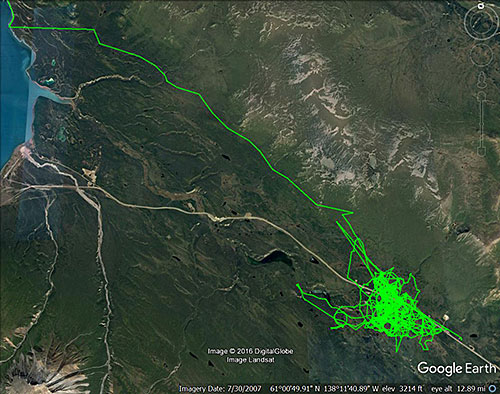
Menzies work is focused in a study area along a 50-kilometer stretch of the Alaska Highway between Haines Junction and Kluane Lake, specifically an area known as the Shakwak Trench between Kloo Lake and Kluane Lake, just outside Kluane National Park and Preserve.
The Kenny Lake lynx was captured and collared in January 2016 right near the Alaska Highway, 13 miles east of Kluane Lake. The GPS device in the collar recorded a location every 30 minutes.
The lynx spent the first couple months right in that area. A Google Earth map of his points shows a home range roughly three miles long and a mile and a half wide, bisected by the highway, crisscrossed by a dense scribble of lines representing his movements between those 30-minute location points.
The other collared lynx show very similar home ranges – areas between eight and 35 square kilometers, overlapping and/or adjacent to each other.
For some reason in late March he took off. He headed west to Kluane Lake, and then followed the lake shoreline about 16 miles north. He turned west again and crossed the frozen lake, continuing west about 80 miles, crossing several large glaciers and numerous rivers. This first 120 miles or so of travel during April shows no discernable dawdling, unlike his movements during late April and May right along the Alaska-Canada border where he backtracks, circles and spends days in the same small area. His route roughly parallels the Alaska Highway between Kluane Lake and the Alaska border just north of the Wrangell Mountains.
Menzies said that on May 26 the batteries in his collar died. The route that took him another 150 miles or so around (or over and through) the Wrangell Mountains and then south to Kenny Lake is unknown – as are his motives.
Menzies wrote: “There have been reports of lynx moving great distances but it is usually in response to declining hare populations in their area (i.e., they disperse to places with more hares available) but the hare numbers are high here. He was not a juvenile, so wasn’t a dispersing juvenile either. So, we are currently unsure of why he moved this far but are intrigued and humbled by the fact that we still have so much to learn about these animals!”
The second lynx snared near Copper Center – also collared by Menzies – was a neighbor to the Kenny Lake lynx. Their initial home ranges (January through March near Kluane Lake) were very close together. The batteries in his collar also died in the spring, so his journey to the Copper River Valley is not documented, but Menzies said it doesn’t appear that they traveled together because they left the area a few weeks apart. He spent time in Kluane National Park near the Kuskawalsh Glacier, returned to his initial home range, then headed west. He may have gone over the Wrangells - Menzies said the highest elevation recorded on his collar was 3,200 meters (10,500 feet), so he was pretty high up in the mountains.
Lohse speculated on several routes the Kenny Lake cat might have taken, but assumed the cat had made the trip in the winter when the rivers were frozen. He said the route he thought most probable required crossing the Copper River, which he didn’t think was likely for a lynx, and suggested the lynx may have followed the highway from Tok and crossed rivers at highway bridges. He was surprised to learn that lynx can be excellent swimmers.
Swimming lynx
Knut Kielland and his colleagues are studying snowshoe hares in Interior Alaska, and their work has led to some in-depth studies of lynx as well. They are looking at conditions that affect hares’ vulnerability to specific predators. They captured and radio-tagged 288 snowshoe hares in an area just south of Fairbanks, and found that lynx and goshawks were primary hare predators, followed by great horned owls and coyotes.
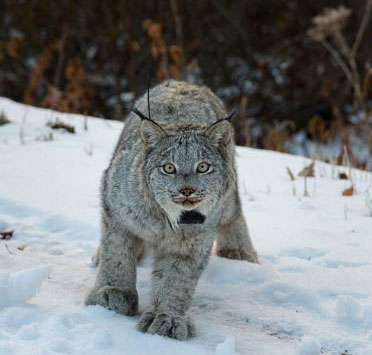
Kielland is on the faculty of the Institute of Arctic Biology at the University of Alaska, Fairbanks. He’s collaborated with the Canadian lynx researchers as well as the USFWS researchers in Tetlin. His hare research led to studies of lynx dispersal and long-range movements, and he and his colleagues collared 23 lynx between 2008 and 2012.
They were surprised to learn that several of the animals repeatedly swam across the Tanana River in October and November, when it was unfrozen or partially frozen. The Tanana is a large, swift, glacial river; it is the largest tributary of the Yukon River and more than a mile wide in places, although there are numerous braids and sandbars. Air temperature was below freezing. One male crossed the main channel of the river six times in November. Another male made 14 crossings of the Tanana between September and November, and swam across sloughs and channels of the river (15 to 50 meters wide) an additional 20 times. A female made 11 crossings and swam across smaller braids, channels and sloughs 40 times.
“Some crossings were made in the dark at night,” he said. “There would have been ice in the river, and it was 10 below zero some of those times.”
Kielland offered some insights into more typical lynx behavior as well.
He said male lynx typically have somewhat "loose" territories excluding other males, but which overlap the home ranges of several females. The size of the home ranges in Interior Alaska and the Yukon vary in relation to prey abundance but typically are between 10-50 square miles.
Males typically tend to disperse farther than females, who, based on Yukon studies, may set up shop adjacent or within their mother's home range. He wrote that, “there are a few documented cases of really long dispersals of lynx, greater than 300 miles, but the Kenny Lake lynx is the first, I think, which was released with a new collar (as opposed to having its hide stretched on a cottonwood board).”
Kielland said that with new tracking technology, researchers are poised to learn a good deal about lynx dispersal behavior.
Cool Tools
The collars used these days by researchers typically contain a VHF radio transmitter, which allows a researcher with a receiver to locate the collar; and a GPS device, which records location points at predetermined intervals. These may be as frequent as every 30 minutes; every six hours is pretty typical and helps conserve battery life. Some collars can be reprogrammed remotely – this enables a bear researcher, for example, to switch the recording interval from six hours (in the summer when a bear is moving around) to once every few days (in the winter when a bear is stationary in a den, hibernating).
Some devices transmit the data back to the researcher, other devices must be retrieved and downloaded. The collar on the Kenny Lake lynx allowed researcher Allyson Menzies to download data while she was within a certain distance from the lynx.
Accelerometers in collars record movement, and in some cases can be set so that if an animal does not move for a certain period of time – several days – the VHF signal changes. This is often referred to as a mortality signal, as lack of movement could imply the animal is dead. The sophisticated accelerometers Menzies has in the lynx collars record activity once a second and the information can generate an actogram – a picture of relative activity. One example shows three months of activity, and that the lynx tended to be inactive for several hours in the early afternoon, likely implying a routine of daily catnaps.
Menzies and her colleagues, Emily Studd (McGill University) and Kevin Chan (Trent University) working in Kluane have some interesting new devices incorporated into the collars. Five of the 14 collars they deployed contained audio recorders, and two of the collars were equipped with cameras. Four of the collars have been recovered and provided researchers with three to five months of GPS locations recorded every 30 minutes per collar; 756 hours of continuous high quality audio, and seven days of photos taken every five minutes.
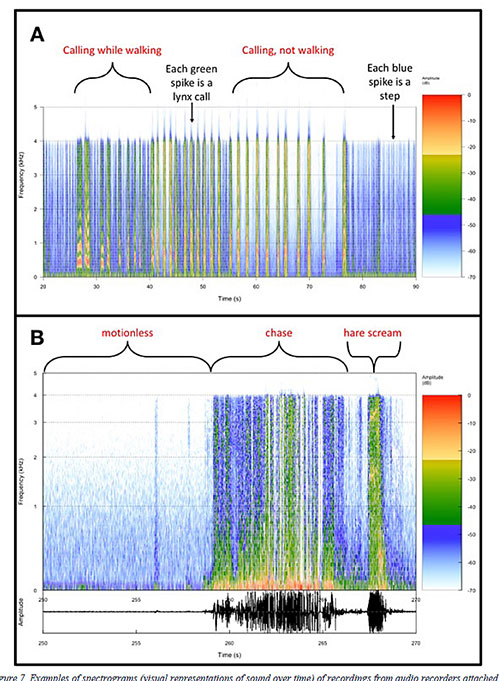
Blood, hair and fecal samples were taken from the captured lynx before they were released. Seven of the lynx were injected with doubly labelled water (deuterium and O18). In the days following these injections they snow tracked each animal and collected fecal samples one to three days after the injection and eight to 12 days afterwards.
Menzies said that by looking at how much of the “heavy” (doubly labeled) water the lynx metabolizes compared to “normal” water, biologists can estimate their metabolic rate and energy requirements for that time period. This provides insights into how much energy they spend in a day, or extrapolated over an entire season or year.
She wrote: “It is interesting to understand the energy requirements of major predators because this determines how much pressure they are putting on the system, in terms of how much food (i.e., prey) they require to fill this energetic need. Energy requirements will change with things like environmental temperature (it takes a lot of energy to stay warm when it is cold), reproductive status (e.g., pregnancy and lactation are extremely costly), and activity or movement rates. As their energetic requirements change over time, their demand and pressure on the system will change along with it.”
They were able to remotely download locations for eight of the collared lynx, and they would hike out in the snow and visit the previous three days of locations. They recorded lynx behavior, habitat, snow conditions and details at kill sites, which resulted in about 300 kilometers of snow tracking. They found 46 kill sites (33 snowshoe hares, seven red squirrels, two spruce grouse, two grey jays and one magpie). They were also able to “spy” on several lynx in the wild and documented the lynx hunting hares and squirrels, courting, vocalizing, grooming, sleeping and feeding on freshly killed and cached prey.
The researchers also set up devices in the lynx habitat to gain insights. Starting in October 2015, another colleague, Darcy Doran-Myers (University of Alberta) deployed 90 motion-activated trail cameras across the study area. As of May 2016, the cameras had captured 395 events of lynx, providing date, time, location and group size. Included in the photos are 16 visually identifiable lynx. The lynx photos are being used in a modified mark-recapture analysis to determine the density of the lynx population in the area. The cameras also took pictures of wolverines, grizzly bears moose and wolves – and they are sharing these with other researchers (with Environment Yukon) looking at wolverines.
In addition to the cameras, in November 2015 they also set up 18 rub pads along a 40-kilometer stretch of the Alaska Highway. The pads snag tufts of hair, which provides genetic information including the identity and gender of the “donor.” This can also provide insights into the population density and population genetics, such as the relatedness between individuals.
As biologists in the north continue their studies of lynx, their prey and their habitat, these elusive cats will become much less mysterious.
Riley Woodford is the editor of Alaska Fish and Wildlife News.
The USFWS researchers in Tetlin have an Instagram account with pictures and information regarding their research.
Subscribe to be notified about new issues
Receive a monthly notice about new issues and articles.
